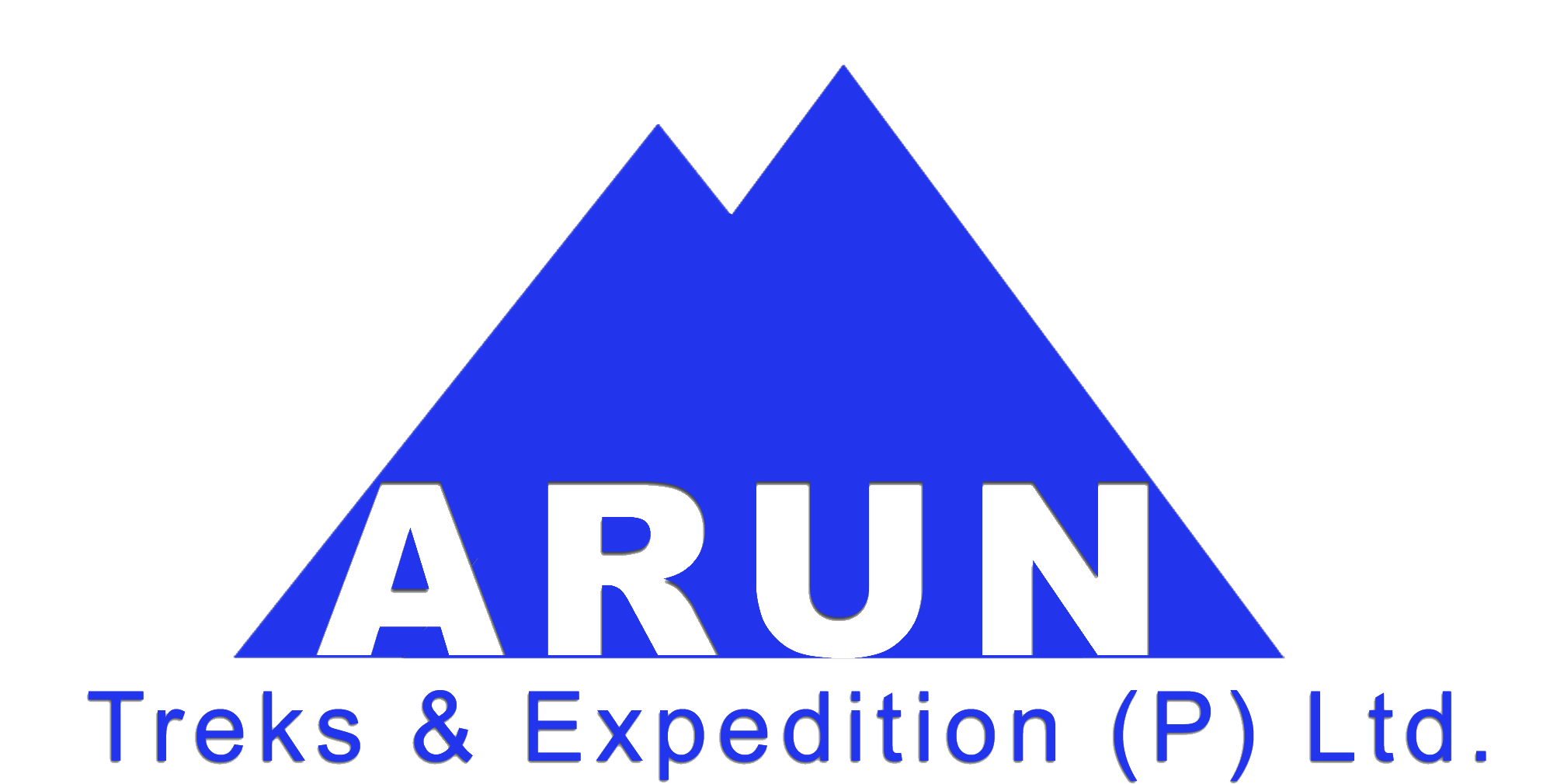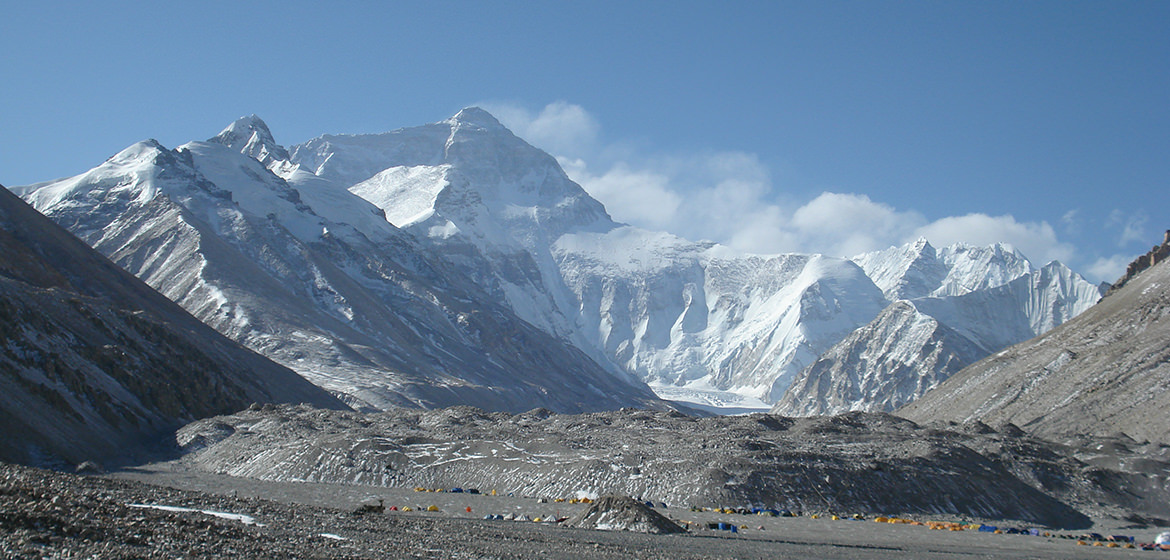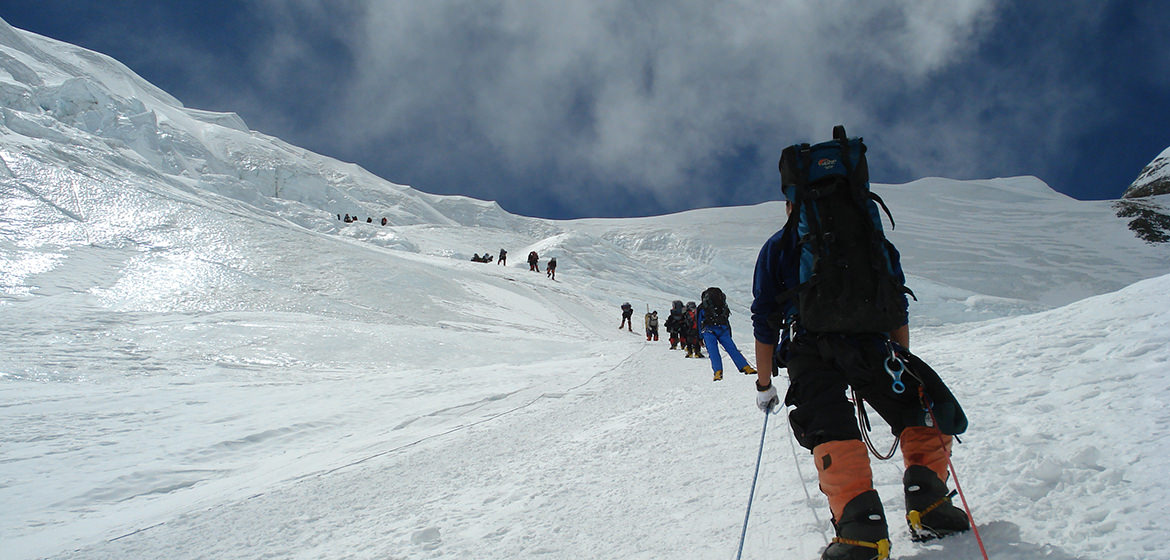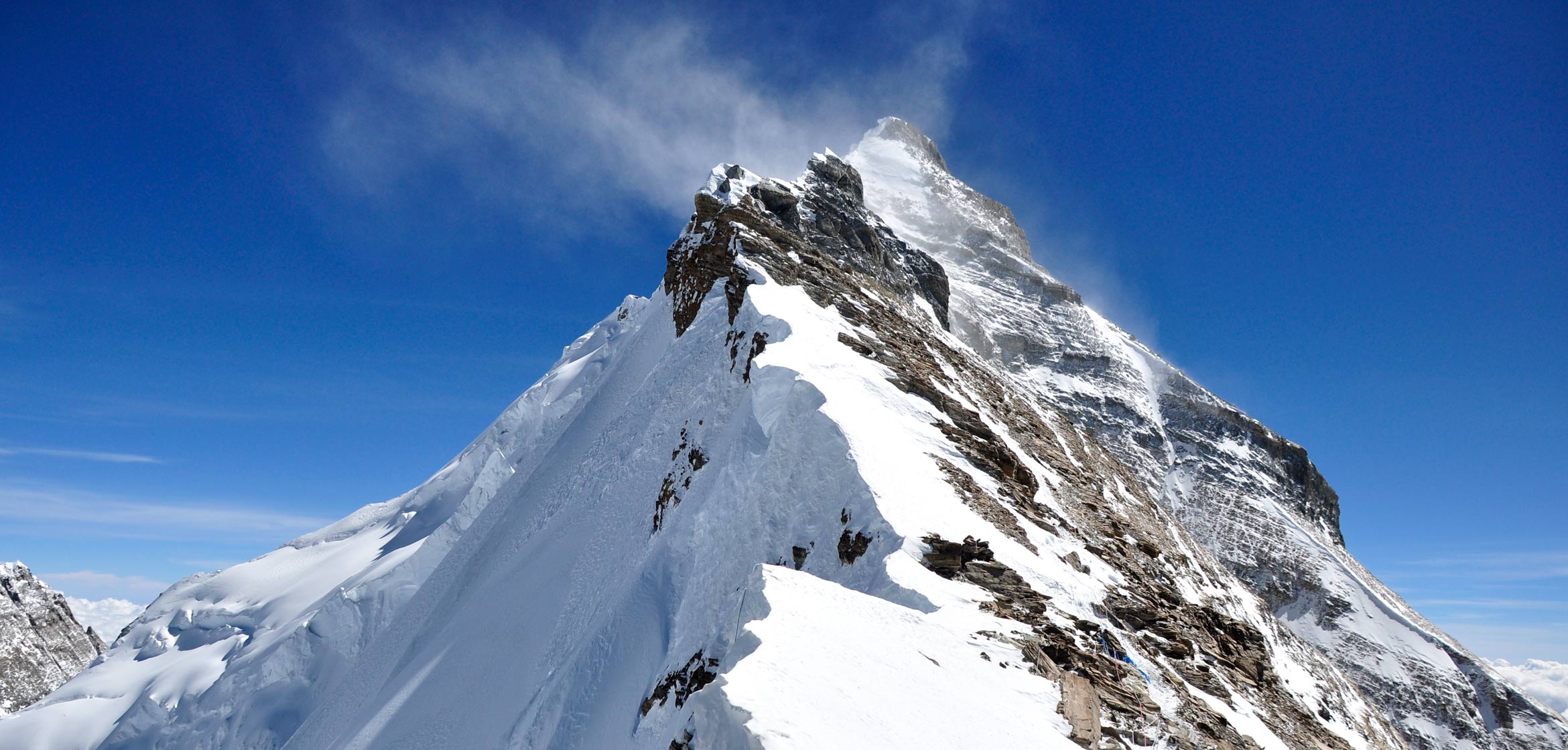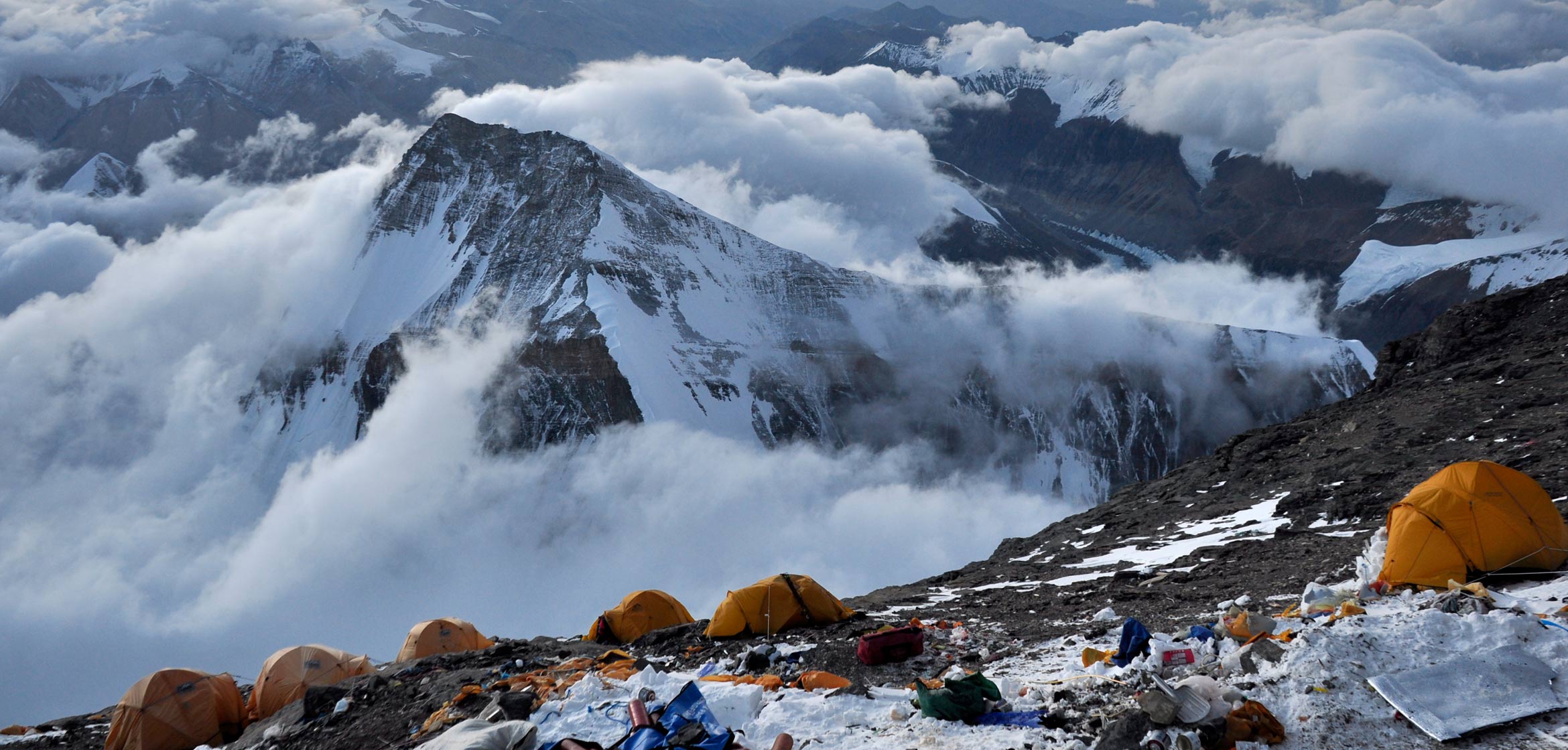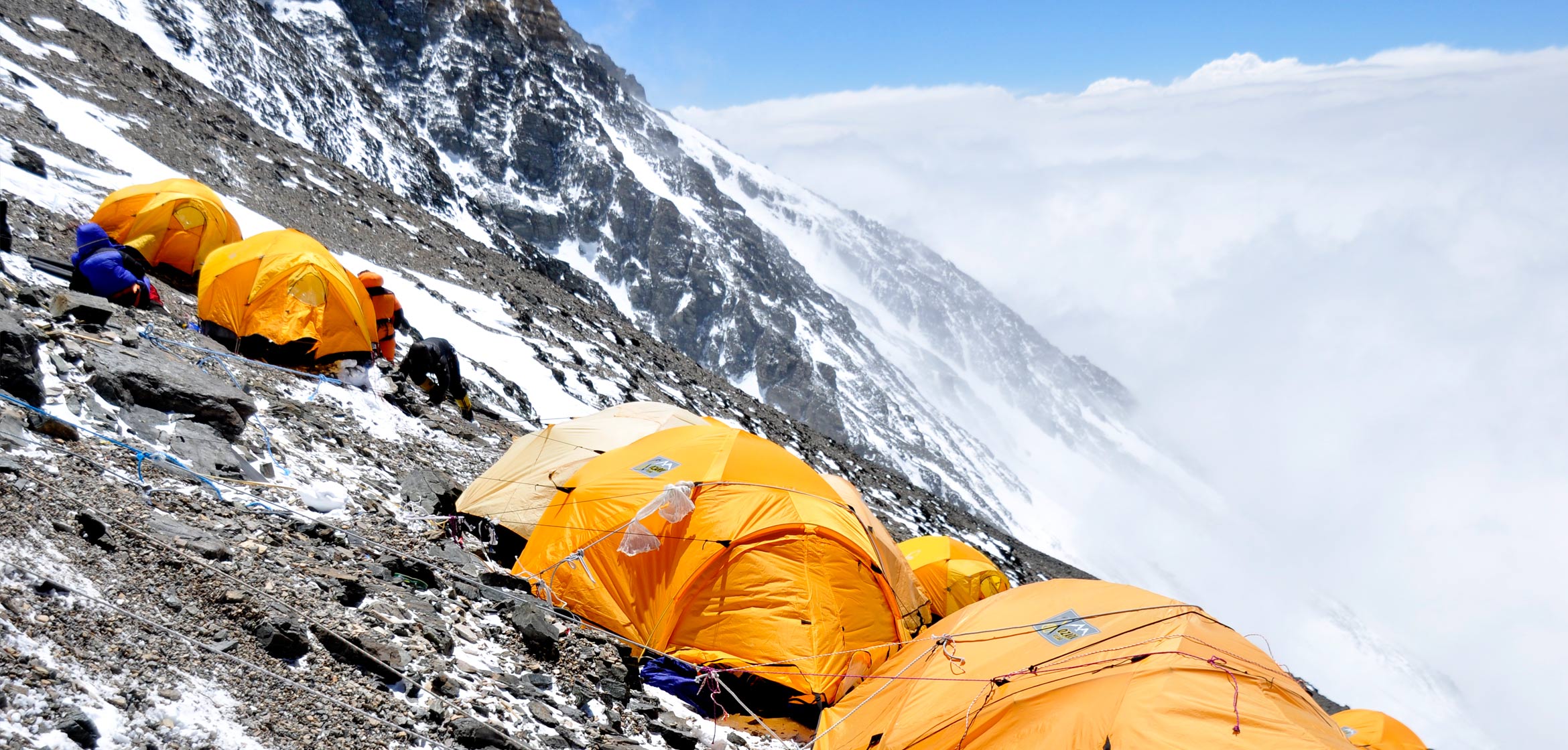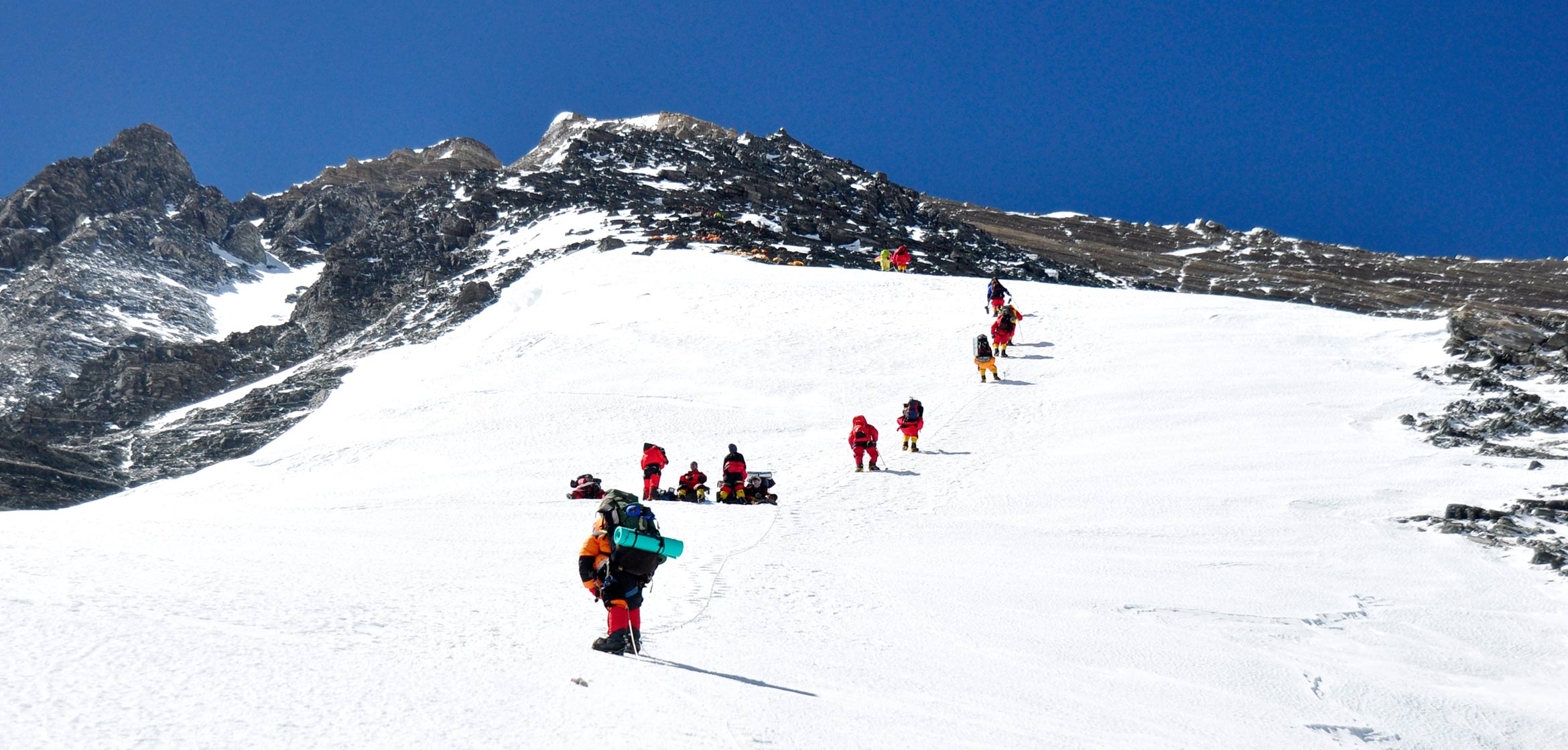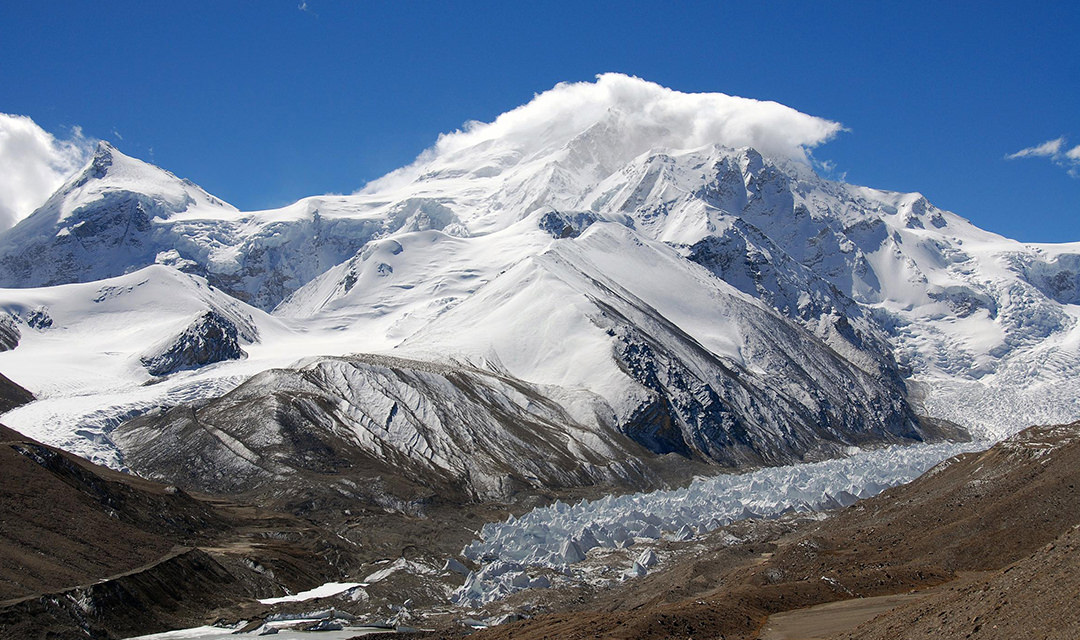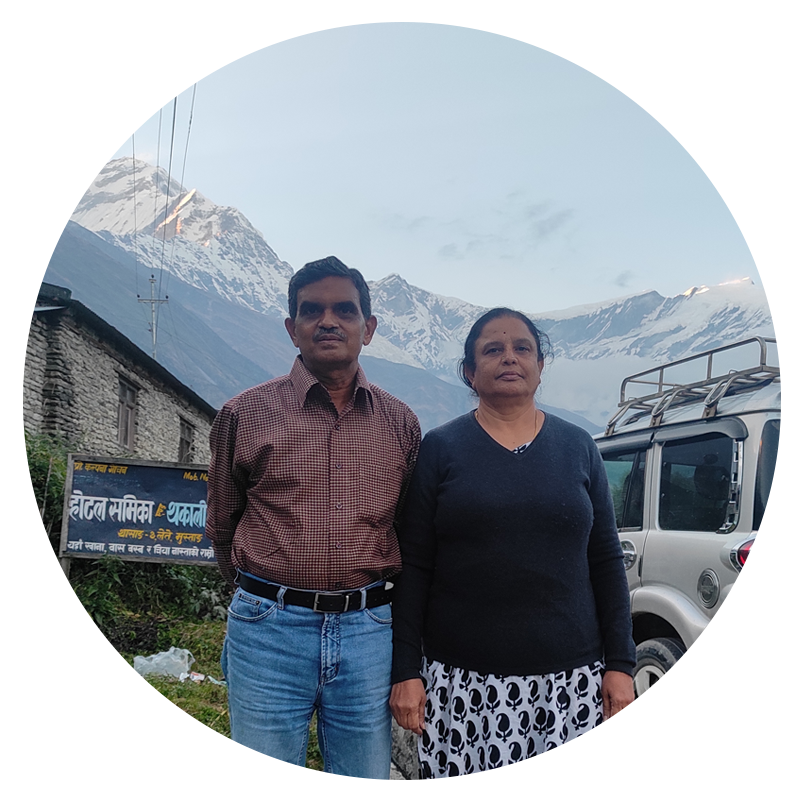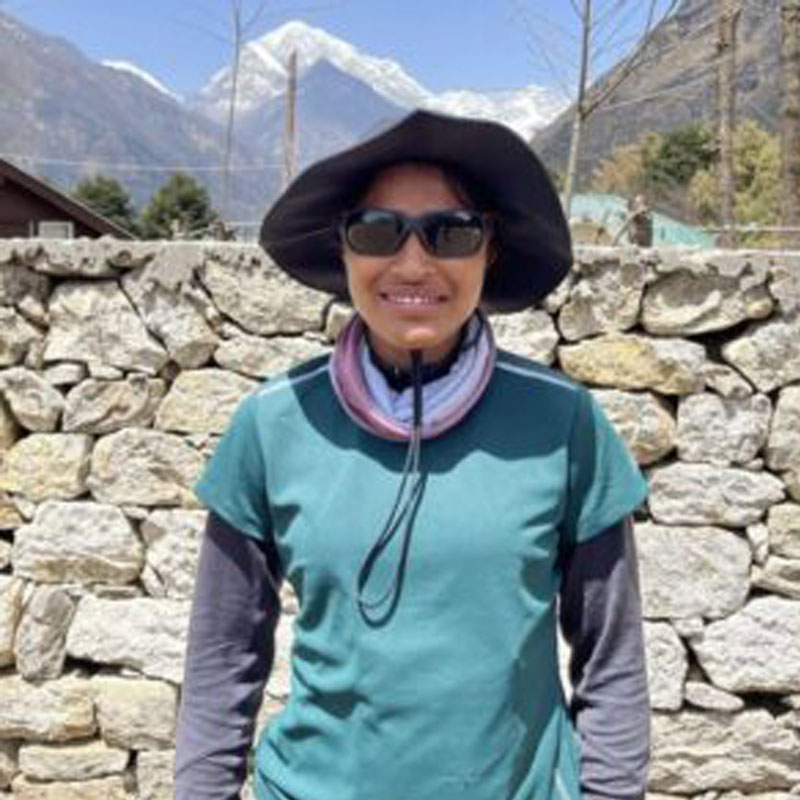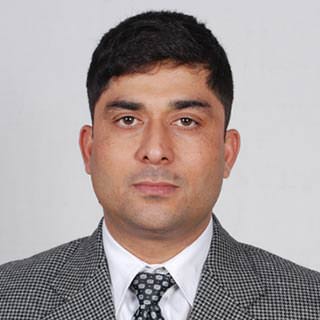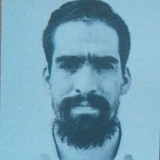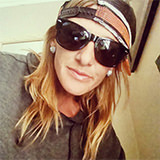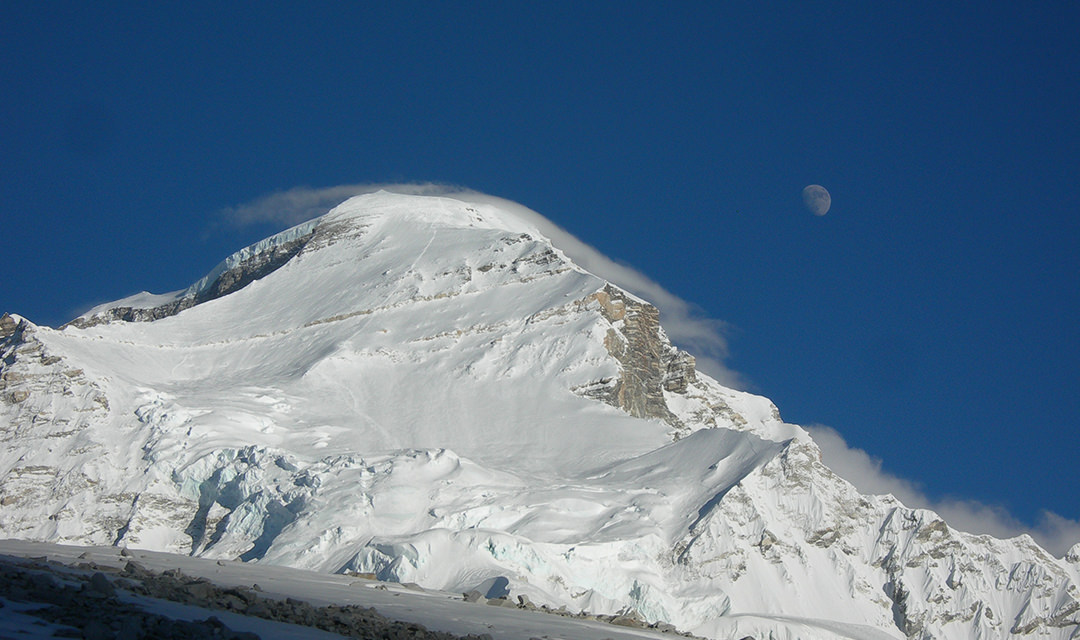
Mount Everest, rising 8,848.86m (29,028ft) above sea level reigns as the highest mountain on Earth. For decades summiting Everest has been considered one of the greatest mountaineering achievements. In the spring of each year, we embrace this intense challenge by taking a group of qualified climbers to climb Mt. Everest via the North Col route of Tibet. We will follow the famous climbing route of Mallory establishing 4 high camps alone with advance base camp, interim camp and of course a relaxing base camp accommodation during the expedition.
EXPEDITION HIGHLIGHTS
-
Climb with one among the top 5 Mountaineering expedition organizing company in the Himalayas (30% of the total Everest expedition in the year 2010 was logistically organized by Arun Treks, and 85% success oriented that year with no any tragic incidents)
-
Climb the world's highest peak, Mt. Everest
-
Climb Mt. Everest from the North Ridge Normal route
-
Climb Mt Everest with experienced Sherpa Guides and climbing sherpas, who have climbed Everest more than 10 times.
-
7 days Scenic drive to some of the world's highest motor-able road in Tibet
-
Experience the unique culture of the Tibetan plateau and its people.
-
Expert & experienced Cooking Crews during the expedition
-
Nice, Friendly & Comfortable logistic arrangements
-
Best quality logistics through out the expedition.
 |
Arrival in Kathmandu |
After finishing your custom formalities (Visa, etc) obtain your bags and appearance for our representative with a Arun Treks display panel at the gate. you may be then transferred to your Hotel. Once sign up, you may visit HGT workplace, meet your trekking guide likewise as different participants and do final preparation for the trip. Later within the evening there'll be a welcome dinner which can introduce you to the Nepalese food culture.
 |
Sightseeing, preparation for expedition |
Take rest, inform, and create a look tour to Kathmandu's World Heritage Sites. we have a tendency to create a guided tour to a number of UN agency World Heritage Sites within the Kathmandu vale. The day also will be for finalizing office work and alternative necessary arrangements. you may be conjointly briefed on the character of expedition, instrumentation and team composition. you'll conjointly create your minute shopping for of non-public things.
 |
Preparation for expedition |
 |
Drive to border, after immigration; drive to Kyirong(Nepal/Tibet border) |
Early morning Breakfast at guest house and drive to Nepal border then immigration formalities Nepal-China afterward, continue drive to kyirong.
 |
Kyirong. Rest day for acclimatization |
 |
Drive to Tingri |
We will see the gorgeous natural depression scenery with intensive meadows and teams of sheep and goats. the remainder of the day we are able to visit alittle gompa in Chholun. Tonight are going to be spent in a very snug bivouac in Lunthang. This bleak region is home solely to herders and barley harvesters.
 |
Tingri. Rest day for acclimatization |
 |
Drive to Base camp |
Depending on the weather, we have a tendency to might explore around Base Camp (there ar some fun places to camp at) for around every week or move up to Advanced Base Camp additional quickly.
 to
to .png) Base Camp
Base Camp
We have a tendency to head for the Everest Base Camp, that is additionally the final word highlight of the total trip. Reaching the bottom of the world’s highest mountain is associate degree accomplishment in its claim. we have a tendency to could capture this accomplishment with our camera whereas keeping ourselves busy with short treks which is able to facilitate us in acclimatizing to the high altitude. At the bottom camp, we have a tendency to conjointly get pleasure from the superb range visual image with the world’s highest peak, Mt. Everest, soaring higher than us.
.png) to
to .png) Trek to Advance Base Camp
Trek to Advance Base Camp
.png) to
to .png) Mr Everest Climbing Period
Mr Everest Climbing Period
We arrange one longer acclimation trip on the mountain and that we could build a second trip up to North mountain pass. we are going to come to Base Camp to recover before creating a summit try. we have a tendency to summit as a team in one or 2 teams. normally solo summit tries while not many backup aren't doable.
.png) |
Trek to Base camp |
.png) |
Drive to Kyirong |
.png) |
Cross border drive to Kathmandu |
.png) |
Kathmandu, free day |
.png) |
Final departure. |
Mount Everest, rising 8,848.86m (29,028ft) above sea level reigns as the highest mountain on Earth. For decades summiting Everest has been considered one of the greatest mountaineering achievements. In the spring of each year, we embrace this intense challenge by taking a group of qualified climbers to climb Mt. Everest via the North Col route of Tibet. We will follow the famous climbing route of Mallory establishing 4 high camps alone with advance base camp, interim camp and of course a relaxing base camp accommodation during the expedition.
ATE (Arun Treks & Expeditions) has been running successful expeditions since 1992 with more than 50 successful expeditions to the world highest peaks. Our profile includes full expedition support to some of the world famous climbers. ATE is also one of the pioneer company to undertake commercial Everest expedition in Nepal & Tibet. Our Sherpas are highly qualified and experienced. All our Sherpas have had high reputation with excellent success rates with safety of client as number one priority.
We are committed to provide you with the best quality of service and experience to help you reach your goal. However, all the climbing members will have had considerable climbing experience at higher altitudes, preferably in Himalayas. Each climber will be aware of the inherent risks - bad weather, injury and death? Associated with climbing the Mt. Everest and understand that the possibility of actually summit is very slim. There will be a manager at base camp to assist the team and act as a liaison between climbers and the Sherpas. All members will be assisted by our high quality Sherpas at the ratio of 1:1, most of whom have summit Everest numerous times.
Advance Base Camp (6400 meters)
As soon as the team will be at Chinese base camp (5500 meter), you can see the already set up tenting. You can stay at BC 4, 5 & 6 days depending on per your physical fitness but during your stay at BC get prepared your personal climbing equipments & necessary clothes in order to take to the ABC. If the client feels OK, no problem with high altitude then team should head to Advance base camp alone with necessary no of yaks. Our in charge of the expedition will prepare the required no of yaks. It will take 2 days from the BC to reach ABC. First night you will have over night rest at middle camp where we have permanent camping accommodation with necessary logistic arrangements like sleeping bag, sleeping mattress, foods & accommodation facilities. Next morning you can make a day trip to ABC (6400 meter). Advance base camp is the place where expedition members can to spend most of time of the expedition. During stay at ABC, clients can gain more acclimatized & able to make trip to the higher camps.
Camp 1 (North Col) 7000 meter: Climbing sherpas will take the necessary food, drinks & tents etc. to the north col before client reach to the there. After spending couple of night at North Col, Expedition members will return to ABC or BC for rest & acclimatized.
Camp 2 emergency camp (7500 meters): The Climbing Sherpa will carry the necessary loads to the 7500. Now clients should move to 7500 from ABC, first night at NC & next night to 7300 & morning back to ABC & tenting accommodation will be ready there. Client should spend a night at 7300 in order to be acclimatized. After spending a night then expedition member will back to ABC directly. Some member will back BC as well. The way from camp 2 to Camp 3 is rocky & terrain, but not so difficulty. But some time, the speed wind will be the problem. From camp 2 to 3 is the main windy section.
Camp 3, 7700 meters: After passing the windy & rocky section, you will be at Camp 3 (7700 meters). Here again sherpa takes the loads & set up the camps before client reach there. Here again from ABC to NC on the first night, next night at 7700, next morning to up to 7900 & direct back to NC/ABC. Sherpa provides you the boiled water/tea/coffee & served the individual pack foods (High altitude food) in the high camps. Walking from the camp 3 to 4, the route is mixed up like snow angle, rocky & some difficulty area as well. Here too the speedy wind will hit you. Clients should go up to 7700/7900 and had over night for acclimatized purpose.
Camp 4 (8300 meters): This is your last camp from where the summit attempt can be made. The team of Sherpas will take all the necessary loads to the camp 4 including the required numbers of oxygen for the summit bit.
SUMMIT ATTEMPT
After all the camps are established and all our supplies are in place, we return to Base Camp for a rest. At Base Camp we will organize our summit teams and prepare ourselves for summit attempts. Taking a good rest & looking the good weather summit window. The first night go for middle camp or direct to ABC, 2nd night go for Advance base camp & stay 2 nights or more to take good rest, 5th night go for North Col, 6th night go for 7700, day 7th go for 8300, the same night go for the summit attempt. Normally the summit attempt starts from the night time 9, 10 or 11 pm. So that you will be at the TOP next morning time. On the way to summit you have to cross the 1st, 2nd & 3rd step then only you are able to stand at the & technical part before summit attempt, you should be very careful about your full climbing gears, Oxygen & mask regulator set & in each step you must be careful yourself.
Once the climbers ascend the 3rd step, they slowly and laboriously proceed to the summit at 29,028 feet. The summit sits at the top of the world. Though not the closest place to the sun due to the earth's curve, it is the highest peak on earth. Due to the decreased air pressure, the summit contains less than one third of the oxygen as at sea level. If dropped off on the summit directly from sea level (impossible in reality), a person would die within minutes. Typically, climbers achieving the great summit will take pictures, gain their composure, briefly enjoy the view, and then return to Camp IV as quickly as possible. The risk of staying at the summit and the exhaustion from achieving the summit is too great to permit climbers to fully enjoy the great accomplishment at that moment.
As most readers of this page know, the return trip can be even more dangerous than the climb to the summit.
However successful attempt to the summit of Mt Everest, even your mission is not complete. You still have had challenges left to be done which is decent down to BC safely, probably you can decent to North col in the first night, then ABC, BC. Only at this stage, the mission Mt Everest is complete. Packing the expedition stuffs then drive back to KTM.
As always, weather plays a major part in all actual summit attempts. We will try as many summit attempts as safely possible as our goal is to put the maximum number of people on the summit. Guides and Sherpa will accompany all summit attempts and oxygen will be used.
EXPEDITION HIGHLIGHTS
• Climb with one among the top 5 Mountaineering expedition organizing company in the Himalayas (30% of the total Everest expedition in the year 2010 was logistically organized by Arun Treks, and 85% success oriented that year with no any tragic incidents)
• Climb the world's highest peak, Mt. Everest
• Climb Mt. Everest from the North Ridge Normal route
• Climb Mt Everest with experienced Sherpa Guides and climbing sherpas, who have climbed Everest more than 10 times.
• 7 days Scenic drive to some of the world's highest motor-able road in Tibet
• Experience the unique culture of the Tibetan plateau and its people.
• Expert & experienced Cooking Crews during the expedition
• Nice, Friendly & Comfortable logistic arrangements
• Best quality logistics through out the expedition.
IS IT RIGHT FOR ME
Fitness
To reach the summit of Everest (29,035'/8850m) you must be in top physical, emotional, and psychological condition. Benchmarks for physical conditioning include successful previous trips above 20,000' whenever possible, during which you will have gained experience dealing with gear and equipment, handling extremely cold temperatures and extreme altitude, gaining solid cramponing skills both on and off rock, snow and ice, rappelling with a pack on, and using ascenders and jumars on a fixed line. In addition to solid alpine living, snow, and ice climbing skills, you need significant strength endurance, high-altitude tolerance, and strong cardiovascular conditioning.
Experience
We are looking for experienced climbers, for whom Everest is the next logical step in their climbing careers. Our team will be in top physical condition and ready to meet the extreme challenges Everest presents. If at all possible, we request that potential Everest climbers participate in one of our other domestic or international climbs. More over the participant must have the knowledge about the previous mountaineering expedition including the mountaineering skill development basic & advance trainings plus well shill to use climbing hard wear gears such as crampons, jumars, prussiks, abseiling. Moving past knots, anchors etc.
It is important that a team member be able to work well with people and be willing to commit to a group effort which will last for several weeks. You will be exposed to a completely different culture during the expedition. Being the expedition team member, it is your responsibility to treat the people and their environment with respect. This ability is as important as your climbing skills. Our object is successful & safety summit attempt, some time on the tough climbing days, you may think, you have been away from home for an extended period of time is highly important. Be determined to finish what you have begin, trained for and set as a goal. Mountains are beautiful places but not every minutes of every day is sunshine & roses. Therefore while on the climbing the mountains focus on your goal & try to be mentally free. Our sherpa support look after your requirements & guide you but you need to be honest and realistic with yourself and your team members.
ACCOMMODATION & FOOD
In Kathmandu: We will be staying at the (3 star)** Hotel (**also depends upon client recommendation). There are many restaurants in Kathmandu catering to western tastes as well as plenty of local Dahl Bhat (rice and lentils) shops at very reasonable prices.
It is safe and clean and well staffed, and is a safe place to leave your clean town clothes and other gear when you are in the hills.
On the Trek: We will stay in lodges before getting to the Base camp and enjoy full camping style services onwards (cook, kitchen hands, morning tea to your tent door, camp sherpas to help with equipment, porters, yaks etc). Some of our head cook has been with us since 1995 and has picked up Thai curries, Italian pastas and a whole host of other dishes, which are very welcoming at the end of a good days trekking. We also have cooked breakfasts and cooked lunches where possible.
On the Mountain: We will use specialized mountaineering tents for our stays at high camps. Food will be prepared by your guide and Sherpas and will be more basic than you might expect at home.
Note: Every lodging service in Tibet is very basic and the meals are all Chinese. So for few days prior to Base camp, you have no choice but to go with the Chinese food.
WHEN TO GO?
Autumn season (Sept-Nov)being the best season for climbing, offers excellent weather and tantalizing mountain views, and also best season for peak climbing.
Summer months (June-September) of the year which coincides with monsoon begins in mid-June and drains in mid-September making travel wet and warm. The mountain views may not be at their best as rain clouds and haze over hang the mountains occasionally obscuring the enchanting views. These times are blessed for the keen botanist as the higher valleys and meadows blossom with flowers and lush vegetation.
Spring season (March-May) is the expedition season and the best time for climbing the high peaks. It is mildly warm at lower elevations but occasional haze mars beautiful view of mountains. At higher elevations over 4,000 meters the mountain views are excellent and the temperature is quite moderate even at night.
Winter season (December-February) is noted for cold weather with occasional snowfall at higher elevations. Again, excellent views are common. These months are popular and ideal for trekking for those who are well equipped or who remain at lower elevations below 3,000 meters. Most of the hotel owners will come to the lower altitude cities like Kathmandu and Pokhara.
Although Travel in Nepal can be organized throughout the year, October through May is considered to be the best months for trekking.
CURRENCY
The unit of the Nepalese Currency is Rupee. One Nepali Rupee is made up of 100 paisa. Nepali Rupee notes come in Rs. 1, 2, 5, 10, 20, 25, 50, 100, 500 and 1,000. Coins come in paisa 5,10,25,50 Rs. 1, 2, 5 denominations. Paisa coins are not currently used for common transactions.
Foreign currency, and traveler cheques, can easily be exchanged at banks or authorized agents. In Kathmandu banks have money exchange counters, which are quick and convenient.
MasterCard, Visa and American Express are accepted at all major Hotels, Travel Agencies, Restaurants and Stores. Only the first two though, are currently accepted at banks for money advances. As from august 2000 ATM services are available in Kathmandu.
In the cities, and specially while trekking, change for Rs500 and Rs1000 bills is not easily available.
BANKING
Banks are open between 10:00 A.M. to 2:30 p.m., Sunday to Thursdays and between 10:00 a.m. to 12:30 p.m. on Fridays. Closed on Saturdays and national holidays. Some Banks in Thamel, Kathmandu are open till late.
TRAVEL INSURANCE
We recommend cancellation insurance to protect your investment. We require participants to have travel insurance that covers medical expenses, Chopper evacuation and repatriation. Please ensure that your chosen policy provides cover for the activities (trekking and mountaineering with ropes and guides) and in the localities in which you will travel (Nepal, to elevations up to 8848m/ 29028ft above sea level).
You may already have your own policy but if not you will need to put something in place. Your nationality will determine what options are available to you to cover this trip. For example the British and New Zealand Mountaineering Clubs provide cover for locals; Australians can look into Insure for less with the appropriate extensions to the standard policy. Whatever policy you take out, you must ensure that is covers the activities you will undertake on this trip.
Note: There are no any Heli rescue services available inside Tibet and are mostly done by land transportation. Nepal heli rescue can only get up to the border of Nepal and Tibet at Kodari/Tatopani.
SERVICES INCLUDES
• Climbing peak Royalty (US00.00 per person), peak registration fee
• Group Chinese visa fee
• Chinese custom clearances at the border
• 05 nights 4 STAR hotel accommodation in Katmandu on single room BB basis
• Private transport from Katmandu to border, to base camp & back as per the group size.
• Truck to carry equipments and food all the way to BC & back
• Full board accommodation en-route to/from Base camp.
• Chinese Liaison office & interpreter
• ONE EXPEDITION EXPERIENCED AND PROFESSIONAL SHERPA GUIDE
• Cook & Kitchen boys at BC & ABC
• Mask & regulator mask set (to be return after the Expedition)
• Highly preferable meals at BC & ABC with complete hot drink & normal beverages
• Exported High altitude food for higher camps
• Best quality tents at BC and ABC single or twin sharing as per the client desire
• All necessary kitchen equipments
• Best quality carpeted dinning tent with gas heaters
• Store and communication tent
• A luxury LOUNGE at base camp (if above 7 pax team)
• Comfortable & portable toiletry facility at the base camp
• A nice portable shower room facility with hot water at the base camp
• Yaks for BC-ABC-BC to carry expedition loads
• High quality high altitude tents for above ABC use
• POISK 4 litters Oxygen 5 bottles to per Client
• Necessary climbing hardware gears with fixed ropes except the personal Gears
• Enough EPI (high altitude) gases with burners for higher camps use
• Oxygen with regulator set for medical purpose.
• Radio walkie-talkie set to each client with base station & permit cost
• Satellite phone for emergency purpose ($ 4 chargeable for personal call)
• Generator/Solar panel with accessories for recharging, power supply and computers use purpose.
• Gamow bag at BC/ABC for medical purpose
• Insurance of all local team members
• All airport/hotel transfers.
• Expedition blessing Puja arrangement at Katmandu and Base camp
• Permanent set up Interim Camp facility between ABC & BC with sleeping bags, sleeping mattress, food & drinking stuffs & of course cooking crew.
• Day tour program around KTM
• Post celebration meals
SERVICE EXCLUDES
• Personal insurance (Suggested to have evacuation policy as well)
• Nepal visa/re-entry visa fees
• Major meals in Kathmandu
• Support Personal Climbing Sherpas
• Personal climbing gears.
• Personal natures expenses
• Cost of emergency evacuation
• Summit bonus & Tips
ILLINESS & EVACUATION
Most of our adventures in the Himalaya take us to remote regions of high altitude. We always take our time to acclimatize properly and we allow for additional rest days. While most people may experience minor ill effects from high altitudes, there are some who have persistent symptoms, which require return to a lower altitude or emergency evacuation. Adjusting to a new diet can also take some time.
All clients are required to have travel insurance covering emergency rescue, usually by helicopter. We must stress that this kind of evacuation occurs in a life or death situation only. Rest and/or descent to a lower altitude are the best remedies for most illnesses experienced out on the trail. Circumstances differ, and the head guide with regard to treatment and itinerary will evaluate each situation. Considering the ill person condition, if helicopter evacuation required then just co ordinate with your guide, he can talk to us, we will arrange the fastest evacuation system immediately. We will work with you to accommodate your needs and requests to the best of our ability. There are small, limited health clinics in some areas, hours of operation dependent upon the season. Additional costs incurred in cases of illness are not the responsibility of mine or will be charged as extra cost.
| Trip Code | - | ATE-EverestNExp |
| Altitude | - | 8848.86m/ 29028ft |
| Grade | - |  |
| Activities | - | 8000M Expeditions (Tibet) |
| Trip Duration | - | 50 |
| Trip Best Season | - | Spring season |
| Group Size | - |
 (Flexible for private groups) (Flexible for private groups) |
| Start/End at | - | Kathmandu/ Kathmandu |
| Destination | - | Tibet |
| Departure Date | - | N/A |
| Cost | - | US$ 32,500 |
| Hotel Info | - | N/A |
PERSONAL CLOTHING
- Travel/town clothes (can leave extras in hotel in KTM)
- Sun hat suitable for snow conditions
- Sunglasses: Category 3 or4, glacier type, UV & polarized are best
- Snow goggles (as for skiing)
- Warm (fleece/wool) hat or beanie
- Fleece scarf or neck gaiter AND balaclava
- 1-2 pairs of thermal liner gloves
- Windstopper fleece gloves
- Heavy mitts with waterproof shell (note: mitts not gloves)
- T-shirt/long-sleeved shirt
- 2 Thermal tops
- Fleece jacket or pullover mid weight
- Fleece jacket heavy weight
- INCL Mid-heavy weight down jacket
- Rain and wind-proof jacket, preferably Gore-Tex
- Rain and wind-proof pants (best with full side zips)
- Trekking shorts&/or long pants lightweight
- 1-2 Thermal long pants
- Fleece long pants, mid weight
- Several pair's socks and underwear
- Trekking boots – we suggest strong leather boots
- Warm boots for camp (e.g. sheep skin boots) *Optional but great!
- Sleeping Bag (-30) 1
- Sleeping bag (-40) 1
- Sleeping Bag linner 1
- Summit liner Shoes 2 pairs
- Summit Gloves 1 pair
- Camp 3 gloves 1 pair
- Trekking sunglass 1
- Summit hot woolen 1 pair
- Liner Gloves 2 pairs
Other Personal Gear
• Sun screen, zinc cream and lip balm
• Wash kit (small personal toiletries, nail clippers and pack towel)
• First aid kit and blister kit
• Personal medicines including your usual medicines
AND 1 course each of (usually available in Kathmandu):
• Respiratory antibiotic (e.g. Amoxycillin)
• Gastrointestinal antibiotic (e.g. Ciprofloxacin)
• Gastro treatment (e.g. Imodium)
• Mild pain killers (e.g. Aspirin/paracetamol/ibuprofen)
• Throat lozenges
• Altitude medication (e.g. Diamox)
PERSONAL EQUIPMENTS
Day pack 70L - 85L
• Down suit
• One sport millet shoes
• Water containers: minimum 3L: e.g. Nalgene wide mouth bottles 1L + bottles or bladder another 2L capacity
• INCL Foam sleeping mat
• An extra sleeping mat (*recommended; e.g. Thermo-Rest or Ridge Rest
• 1 Summit down sleeping bag for high camps
• INCL Sleeping bag for base camp and trek use
• Water-proof bag for sleeping bag (e.g. dry bag or robust plastic bag(s))
• Head lamp (we suggest Black Diamond with LED), spare batteries
• Pee bottle — wide mouth Nalgenes are good *Optional
• Crampons Alpine style with rapid-fix bail type to suit your boots (e.g. Black Diamond Sabretooth)
• Gaiters (for snow) appropriate to your plastic & trekking boots
• Adjustable trekking pole(s)
• Ice axe: one only, 65-75cm in length
• Climbing harness with a belay loop, adjustable leg loops
• Belay/Abseiling gear: e.g. Black Diamond ATC
• Ascender e.g. Petzl expedition ascender
• 2 Non-locking carabineers
• 2 Locking carabineers (wide gate preferred)
Group Equipment Supplied
INCL Group medical kit (for altitude illness, trauma, reserve antibiotics); emergency oxygen and portable altitude chamber
INCL Satellite phone (pay for air time used: USD /minute)
INCL Sleeping tents, dining tent, all cooking and eating equipment & food on trek/climb
INCL 240VAC generatorat BC to recharge camera batteries
INCL Barrel or duffle bag for transporting personal gear by Yak and truck
INCL Climbing ropes, fixed safety ropes
INCL Snow anchors, ice anchors, rock anchors, v-thread cord
NOTE: You must have all of the above personal gear, clothing and equipment. It may be possible to buy some extra equipment (If forgotten) but don't rely on it.
R: This item is available to rent
INCL: This item included in package
Arun Trek's trip web pages, and pdf info packs have lots of info about each specific adventure (search for your adventure here). You may also like to look at our photo galleries or videos for a taste of adventure, or download a wallpaper to inspire you at your computer. This page has answers to some more general Frequently Asked Questions (FAQS) about climbing.
As all of our mountain climbing adventures begin with a trek, you might also like to look at the Trekking FAQs.
If you have other questions, please ask our friendly team, by email, phone, and skype.
Q) Can I really climb a mountain? Do I need to have climbing experience? How can I climb Mount Everest? Can I climb the seven summits?
A) The level of experience and skills required depends on your particular goal (search for your adventure here). We suggest that people undertaking a first climb should have had at least overnight trekking experience. For those who wish to take on a technically difficult, remote or extreme altitude mountain we'd expect participants to have appropriate experience and skills. Some ideas for preparing for climbing goals are given at the bottom of this page.
Q) Why go on a guided expedition?
A) There are many reasons that might make a guided expedition attractive even for experienced climbers. These include someone else taking care of all those details (including thing as diverse as booking and confirming hotels, checking the number of evening snacks, ensuring reliable support, transport, permits, visas, team members, gear, etc etc etc etc). This saves your time and energy for the part that really matters - working on achieving your goal. The high levels of support and experience aim to give you the best possible opportunity to succeed, a high level of risk management, and the Arun leaders and staff are there for YOU!
Q) What type of people comes along?
A) Climbing expeditions usually attract people in their twenties to fifties. Participants tend to be seeking a good quality, safe, well supported, good value and enjoyable adventure rather than the lowest cost.
Q) How fit do I need to be? Will I have to carry a lot of weight? Should I be able to do 100 chin ups?
A) The fitter you are, the more fun you (and your companions) will have. You will find guidance on preparing for your expedition on each adventure's web page (search here), our info packs and trip dossiers. A minimum level of fitness would have you being able to walk all day on uneven, hilly ground, carrying your day pack, and be able to get up again the next day. Many climbs will require a higher level of fitness and strength so you can carry heavy gear to high camps and really exert yourself on summit day.
Q) What gear is provided?
A) Included are individual sleeping tents for the trekking phase of most climbing expeditions, with dining and kitchen tents. On the mountain participants share serious, proven mountain tents. Climbing teams are equipped with emergency communications and first aid equipment as well as more prosaic things like climbing and cooking gear. There is a detailed gear list for each adventure which outlines what we provide as well as what you should bring. (Search here for specific adventures and download the info pack.)
Q) What's the food like?
A) Food arrangements are specific to each adventure, but you get three meals a day while on the track. In cities included is breakfast and, depending on the trip and the nature of the activities may also cater for lunch and dinner for the group. In the Himalayas the kitchen staffs have been training for years and work magic over gas or kero stoves in their kitchen tent.
While trekking the cooks prepare a varied menu of wholesome, tasty and plentiful food using fresh ingredients where possible. A trekking breakfast in the Himalayas usually includes cooked foods e.g. eggs, tomatoes, cereal or porridge, toast & spreads and fruit and a selection of hot drinks.
Lunch is often soup and a packed lunch, or a cooked lunch. Dinners are generally soup, a main meal (one of many Asian or European style dishes) veges, and a dessert (fruit to custard to baked apple pie!) Drinking water: will be provided at camps (collected with care, filtered, treated with chemicals and/or boiled), and at lunch time where possible. It is wise to carry a small amount of purifying chemicals (e.g. Iodine or chlorine) with you, in case you happen to need water at an odd time. In the developing world care should be taken to avoid untreated water and potentially contaminated foods like uncooked salads and some fruit. Bottled water is available in cities, but of course you can treat tap water in your own bottle too.
On the hill we eat easy to prepare food, often prepared by the team with assistance from guides and staff: freeze-dried foods, crackers, soups, snacks etc. On big mountains it is often a challenge to eat, so we provide foods to tempt your appetite and give you sustenance.
Q) Who will be responsible for my safety?
A) The short answer - you! All participants are expected to behave in a responsible manner, taking due care of themselves and others. Your expedition leader is responsible for the group including participants and staff. He or she will advise, manage and assist everyone, sometimes with the support of an expedition first aider or doctor, and will be assisted by guides, sherpas, and you and your climbing colleagues, all of whom will have roles to play.
Q) What if I get sick or have an accident?
A) Despite the best precautions, people do sometimes fall ill, sprain something or develop symptoms of AMS. Our expedition leaders will manage your care keeping in mind what's best for you and the rest of the group. Precautions include first aid qualifications and kits, emergency communications, evacuation plans, your travel insurance cover and our pre-preparation and medical advisors.
Q) What about altitude sickness?
A) AMS Acute Mountain Sickness (or altitude sickness) is the body reacting to the stress of high altitude. It is a concern for trekkers in the Himalayas and elsewhere above about approximately; say (is that enough vagueness!) 3,000m. Exposure to high altitude can lead to a number of 'normal' physiological reactions as well as mild to extremely serious illness and even death. The treks are designed with relatively slow acclimatisation schedules, rest days and alternative options. And there are medications and a number of management strategies in place should they be required. Don't be unduly concerned, but please talk to us if you have questions.
Q) I don't have much time, can't we do it quicker?
A) The adventures are designed around what we feel is the optimum itinerary, which incorporates adequate time for the suitably fit participant to do the climb comfortably; flexibility for weather, illness, unforeseen delays; time to enjoy the experience, your climbing colleagues and staff; learn about your surroundings if you wish; and, for altitude adventures, a fairly slow acclimatisation regime to minimise the risk of altitude sickness and maximise your chance of reaching your goals. All while also trying to minimise your time away from home. We would generally not recommend shorter itineraries (such as those used by less scrupulous operators) unless you were genuinely prepared to turn back if you (or your travel companion) becomes affected by AMS. If you really don't have the time available, we can perhaps suggest an alternative itinerary or goal that will work for you.
Q) My friend would like to visit, but isn't really interested in climbing...
A) Your friend, spouse, family, colleagues may like to join you on the trekking phases of the expedition, and could stay in Base Camp or Advanced Base Camp, depending on the trip, when you are on the hill. If they want to accompany you to our base city (e.g. Kathmandu) we can easily arrange extra accommodation, and places on our day tours, but we may also be able to arrange a series of day trips, a short relaxing trip into the country-side, scenic flights above the Himalayas, wildlife safaris and so on. Ask us for ideas, or suggest your own.




